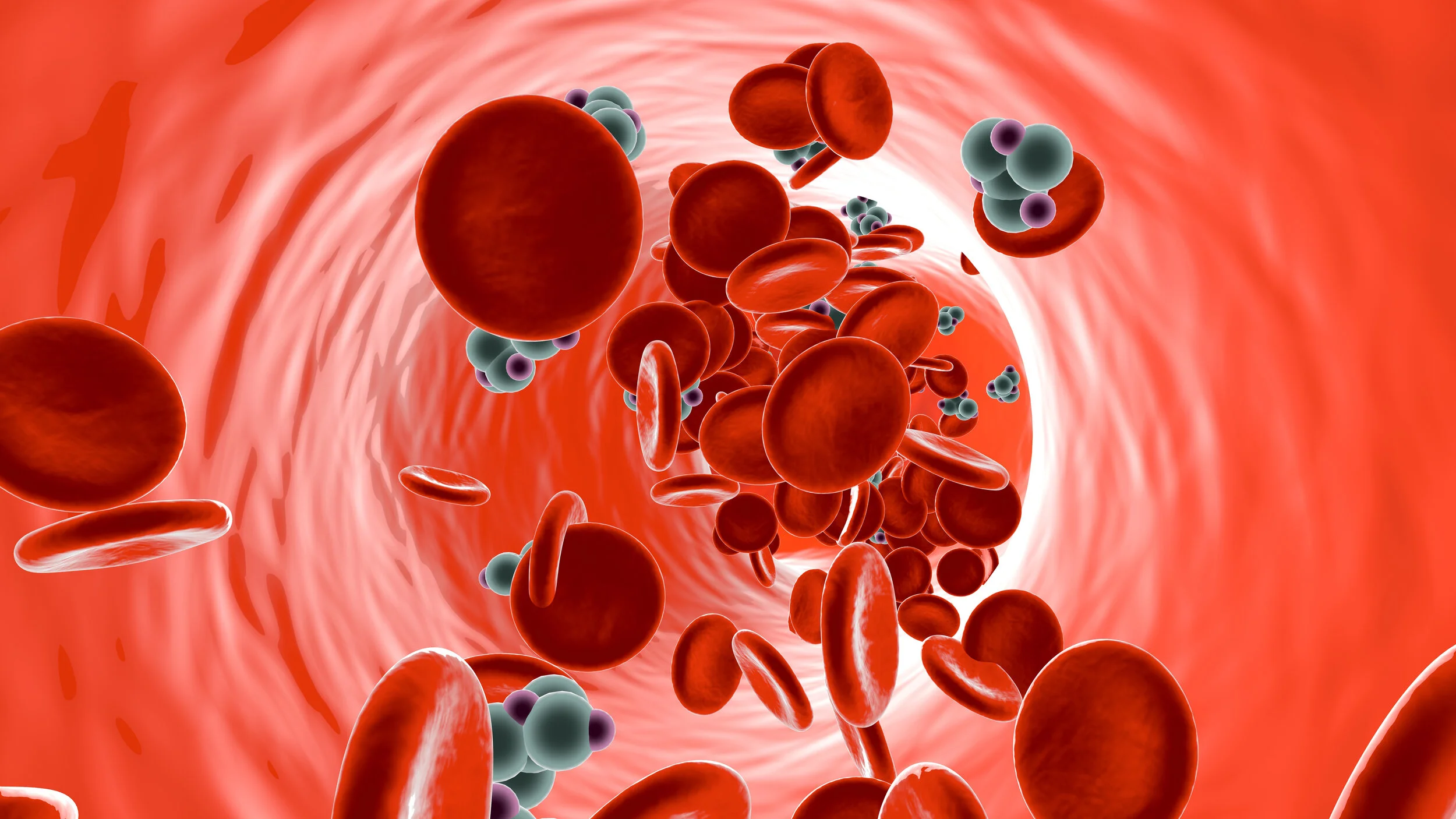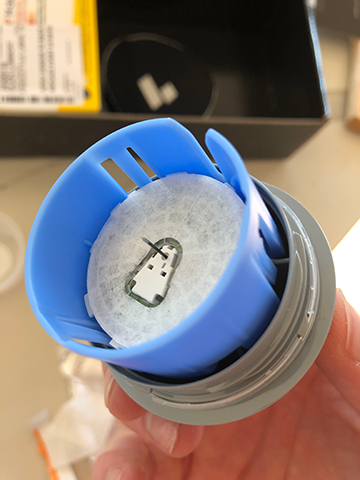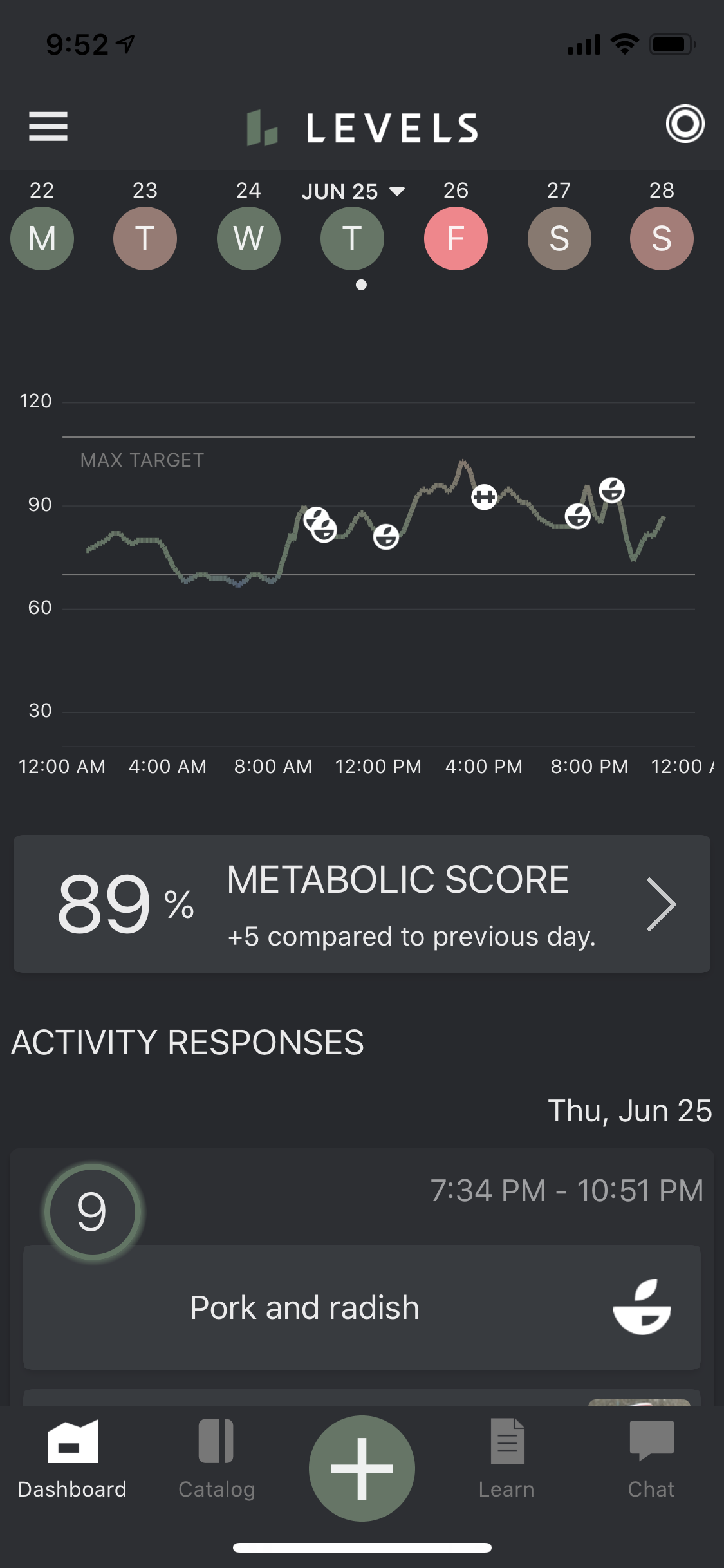A few moments after the needle was inserted into my right arm and the sensor was visibly attached to my body, I realized this tracking experience was going to be much different.
I was literally going deeper, moving from the external tools I use to track and optimize my health, like my iPhone, Apple Watch and Oura Ring, to a sensor inserted into my body.
The sensor was a continuous glucose monitor (CGM) from metabolic fitness company Levels, which is in a beta phase as the company tests and refines its solution to help "maximize your metabolic health so you can live longer, fuller, healthier life."
This means I was wearing two sensors for one month to see the metabolic impact of everything I was eating in an effort to manage my energy levels and eliminate crashes that come with spikes in blood glucose.
Managing the food you consume isn't easy, and I definitely don't get it right a lot of the time. I do continue to make small changes to the foods I consume, how I consume them, and when I consume them, which has led me to test Levels’ solution.
“Diet is the single biggest thing you can change to quickly change your entire life,” Dave Asprey, author of New York Times bestseller The Bulletproof Diet recently wrote in his popular newsletter. “It's the foundation for upgrading your IQ, managing stress, preventing disease, and optimizing physical performance.”
The reality though is your body’s personal response to foods does not always equal anyone else’s response. We can only take the recommended guidelines as just that, recommendations. We have to experiment to learn what works for us individually and pursue personalized nutrition.
So here I was then with a sensor now fixed to the underside of my right arm, at all times, for an entire month to do just that.
The upside is this data would provide real time insights into my diet rather than a check-in report that I had been getting through blood tracking with Inside Tracker or microbiome tests as I did from Viome. My expectation was that this immediate feedback would allow me to really tweak my food intake for my unique body like nothing else I've tried.
Why Track Glucose Levels?
“An optimal diet, when seen through the lens of glucose levels, should focus on foods that minimize post-meal spikes,” according to Levels.
Excessive spikes are dangerous for many reasons. Among other issues, they’re a risk factor for development of type 2 diabetes, cardiovascular disease, liver disease, obesity, stroke, cognitive dysfunction, cancer, and mortality.
Traditionally, the Glycemic Index, a ranking of carbohydrates in foods relating to how they affect blood glucose levels, has been our guide to help prevent spikes in our blood sugar levels and avoiding the post-eating "sugar crash." However, as a new research has shown, two people can have radically different responses, even two opposite responses, between two foods with similar index scores like bananas and certain breads.
It’s more likely that personal genetics, lifestyle, physical activity, body type, and microbiome all play an important role in reducing glucose spikes after a meal.
"It's not the food you eat but what your gut microbiome does with the food you eat that matters most when determining what foods are ‘healthy’ for you or which can give you sustainable energy during the day," according to microbiome testing service Viome. "The functions of your microbes (what your microbes are doing) determine how your body absorbs and utilizes nutrients."
Wearing the Sensor
The sensor provided by Levels is actually an Abbott Lab’s sensor created to help people manage their diabetes. Levels provided two sensors for the month long test along with three black Levels branded patches (or Performance Covers as Levels calls them) to wear over the sensor to help keep it in place during daily activities and exercise.
The application of the sensor was painless. After showering, I rubbed down the area on the back of my right arm between the elbow and the shoulder with a cleaning towelette. The applicator pushed the tiny needle into my arm and the adhesive easily attached to my skin.
The directions noted to keep the sensor from getting wet during a shower for no more than three minutes and no swimming. It was the beginning of June when I started this experiment, and we were finally exiting out of quarantine lock-down with outdoor summer activities just beginning. I thought that might be an issue, but the pool was delayed opening in our building, and there wasn't too much activity since we still were physically distancing. Still, I'd probably keep this in mind when deciding what time of year to do this experiment.
Showering was fine too, but I did hit the sensor during the first couple days when I turned to reverse the car and bumped it on the seat. It didn't hurt, but certainly made me more aware that I had something new attached to my body.
What I learned?
Now that I had this device attached to my body, I was eager to get the feedback.
During the initial 15 days of the month when I was wearing the first of the two supplied sensors, I was mostly testing to see how various foods impacted my glucose levels. I was often eating foods that weren't in my regular day-to-day diet simply to see how my body would respond.
For example, I was on a short road trip after quarantine ended and pulled off the highway for fuel. As with most highway exits, there was a McDonald's. So I decided to see what just a small amount of fast food would do to my glucose levels. I pulled through the drive-through and ordered small fries and a small coke.
Each meal in the Levels app is scored on a range from 0-10, with 10 being optimal and zero the opposite.
The score is a "composite of glucose rise from baseline, height of glucose peak, and recovery time back to baseline, all of which are associated with metabolic health," according to the Levels app.
Not surprisingly, McDonald's fast food isn't good for metabolic health, even at a very small amount. It scored a zero, the only zero any meal I had during the month long program.
Surprisingly, whiskey and other spirits have no significant carbohydrates in them and did not impact my glucose levels. Wines tend to have less carbohydrates than beer, but still have an impact.
Obviously, if you mix a spirit with a sugary mixer, it will increase glucose levels. This was true with my second worst meal, which scored a 1, margarita with its sugary mix, carb heavy chips and salsa with fajitas.
The goal for every day is to eliminate any spikes in your glucose levels.
"It should be flat and smooth like a wave in the ocean," Levels Mike DiDonato, Head of Customer Success, told me during our mid-point check-in call. Since the company is in beta, there were several live calls with the company to give feedback on the product and discuss any questions I had about the program. These calls were really useful to help understand this new area of tracking for me.
Each group of eating periods is given a ranked score, like the zero for McDonald's, and the day overall is given a color. Green was designated for good while shading into red depending on how low the day scored. You can also snap a photo to go along with your meal to get an idea of what you are eating and its impact.
In general, I’ve found meal tracking to be mostly a painful data entry exercise vs it’s benefit. I've tried many food tracking apps such as MyFitnessPal and Lifesum, but what makes Levels so useful is the passive data tracking and immediate feedback. Between the scoring and color coding, it helps nudge you in the right food choice direction.
During my mid-point call with DiDonato, we talked about an unexpected spike I was having after drinking my morning protein shake. He suggested removing one item at a time to see what might be the cause. He also suggested I include chia seeds for the fiber.
That’s when he introduced me to the concept of sequencing when eating meals with carbohydrates. He said eating proteins and fibers before the carbs can reduce that glucose spike.
I was also reminded that we are all different and that banana in my shake does break down uniquely for each person. While we already did include chia seeds in our protein shake, I was able to isolate the culprit of the glucose spike: pineapple. Sadly this delicious fruit was removed for me.
My favorite energy bar also scored poorly and caused a spike. I love Kind's Caramel Almond & Sea Salt bars, which are labeled low glycemic index. However, for me, they consistently corresponded with a large spike in glucose levels (I tested many times because I love them so much). This doesn't mean I've given up on them. I'm just more intentional about when I'm having one and know there's a corresponding crash on the other end.
The Final Debrief
I had one final call with the Levels team to discuss my experience and ask any additional questions.
At this point I had removed two sensors from my arm. At the half-way point 15 days in when I began to pull off the first sensor, I realized it was a little more work than I expected. It required more force along with carefully pulling at it until the adhesive that went on so easily slowly pulled off my skin.
It felt really good to take it off and let the skin heal, which was left with a small red mark that was slightly itchy. Both irritations went away overnight. After the night’s rest, I once again inserted a continuous glucose sensor on the back of my right arm, quick and painlessly.
Toward the last two days of wearing the black Levels patch that covered the sensor, it started to fray and the sides drooped a bit. That's probably why they give you three. It felt like taking a big bandaid off when taking off the patch. I also thought the size of the patch was larger than I'd like to be sporting around, especially in the summer.
I mentioned this to DiDonato during our debrief. He said there's several prototypes of the "Performance Covers" out there of different sizes and applications. I'm sure this is one area they will have solved when they do come out of beta, which he indicated would probably be early next year.
I also received a beautifully designed final report. Overall the app’s user interface is one of Levels key values. It makes the data easily useful and the app is a delight to interact with.
The final report gave me an overview of my month-long program highlighting several areas including my overall Metabolic Fitness. According to the report, I saw a 10% positive improvement in metabolic fitness during the 30 days. I'd probably have done better if I wasn't so intrigued just testing the impact of different foods on my glucose levels. Overall, I learned I spent 93% of the time in the optimal glucose range, and Fridays included my worse scores.
Which brings up one of the key questions the Levels team was interested in knowing about during its beta phase: how often would I want to use the product. As I mentioned, it was nice to take the sensor off mid-way. Not only did my skin feel better, even on the back side of my upper arm, it was quite noticeable with short sleeves and not ideal for swimming during the summer.
Plus with any of these services that give you insight on what you should and shouldn't be eating, changing habits often takes time. I recommended a three to six month cadence to check in and continue to learn and adjust during various seasons of the year when eating habits naturally change.
Using the Levels app and the continuous glucose monitor for a month was a powerful experience. The app is very well designed and continued to improve throughout the time I used it during its beta. The immediate feedback and passive data tracking made it a more ideal solution for diet optimization than other tools. And the beautifully designed final report gave me insight into a month of my eating habits more useful than any calorie tracking solution I’ve tried.
I'd like to use Levels again during a different time of year, like around the holidays or training for a race, as the immediate feedback was helpful in changing my behavior, or at least being more intentional about eating those carbohydrate rich foods.
What impressed me after speaking with Levels’ CEO Sam Corcos was his commitment to getting the cost for this service to reach a point where everyone can afford it. Currently, 10% of the US population is diabetic and 35% of the population is prediabetic.
With the impact it has on overall health and longevity, glucose monitoring is more than a “nice to have,” it will be a necessary solution for all.








